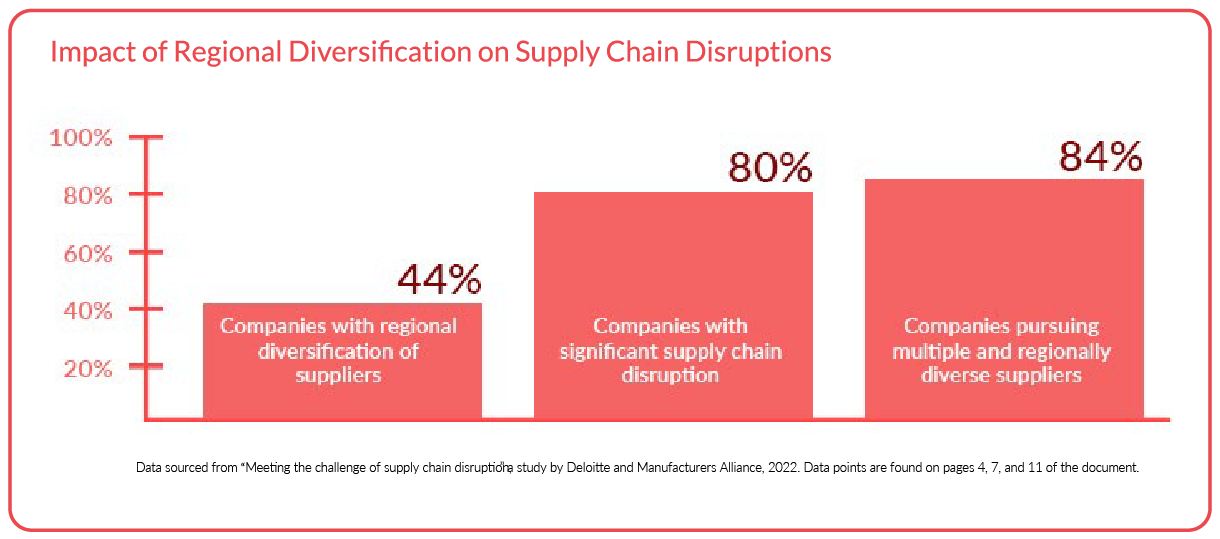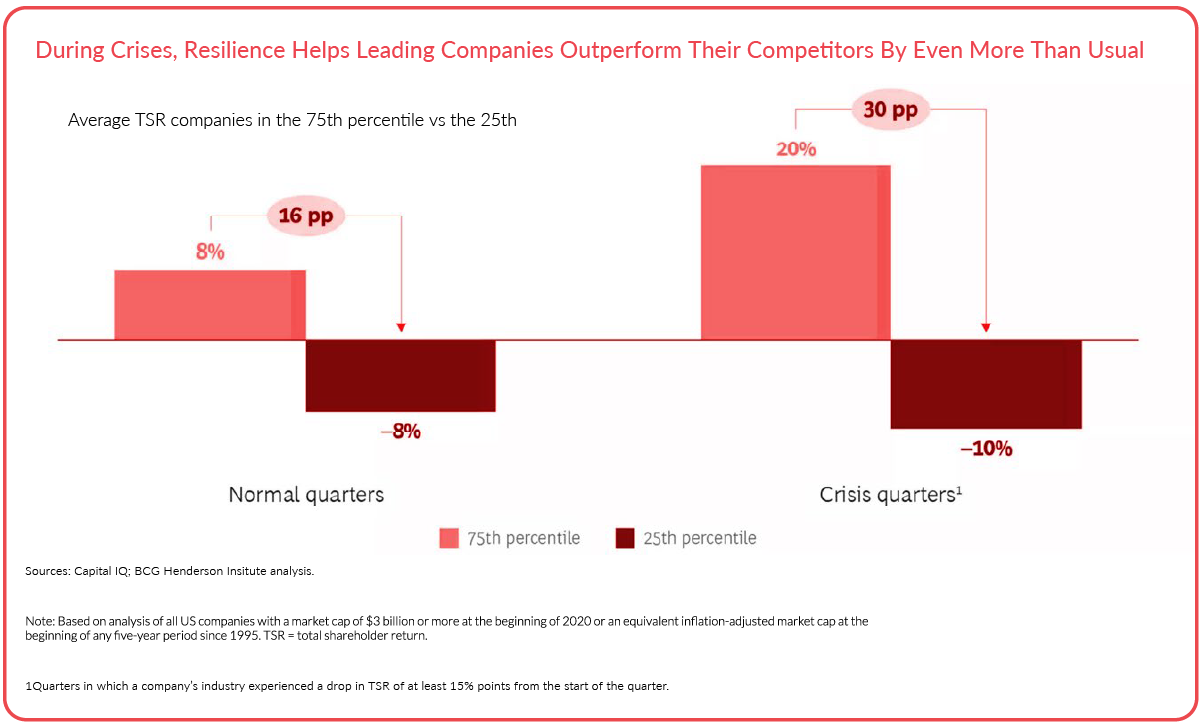
MacroFab Blog
In an era marked by market volatility, the electronics industry is increasingly leveraging supply chain and manufacturing diversification as a strategic linchpin. This strategy is a crucial buffer against escalating trade tensions, political instability, and a rising tide of natural disasters.
Electronics companies that diversify their electronics suppliers, sourcing locales, and manufacturing sites bolster their defenses against potential disruptions. This approach also fortifies their negotiation power and heightens their agility in response to shifts in demand.
Embracing diversification creates resilient systems; a study by Deloitte showcased a 20 percent reduction in disruptions during the COVID-19 pandemic for companies with diversified supply chains. Furthermore, the Global Semiconductor Alliance observed that diversified manufacturing operations could fulfill up to 95 percent of demand amid the pandemic.
Industry leaders, Intel and Samsung, exemplify successful diversification. Intel has inaugurated new manufacturing bases in the United States and Europe, while Korean-based Samsung has broadened its smartphone production away from China to points across the globe. Their actions underscore the potential of diversification to reduce risk, enhance resilience, and augment profitability in a turbulent market.
These actions demonstrate that diversification can significantly mitigate risk, improve resilience, and bolster profitability in an increasingly volatile market landscape.

This paper delves into why diversification is imperative for today’s electronics enterprises, and how it can act as a potent catalyst for resilience and robustness amidst disruption.
Diversification of Supply Chain Sources
Supplier diversification plays a pivotal role in ensuring manufacturing resilience in real-world cases. A prime example of this is Tesla, a leading player in the electronics and automotive industry.
Amidst the recent global semiconductor shortage, which caused considerable disruption in the electronics industry, Tesla showcased the merits of diversification. When the supply of their critical chips, used for varied controls, infotainment, and self-driving software, was hampered, Tesla rapidly pivoted to alternative microcontrollers. In tandem, they formulated firmware for chips manufactured by different suppliers.
Tesla’s nimble response, facilitated by a diversified supplier portfolio, enabled them to uphold their production schedules effectively, even amidst electronics supply chain upheaval. This instance emphasizes the resilience supplier diversification provides against unexpected adversities, underlining its criticality in the electronics industry.
Moreover, supply chain resilience positively impacts a company’s performance and value. An analysis of approximately 1,800 US companies from 1995 to 2020 revealed that resilient companies outperformed their peers during crises.
In stable quarters, the average total shareholder return (TSR) gap between the industry’s 75th and 25th percentile performers was 16 percentage points. However, this gap nearly doubled during crises to 30 percentage points, showing that the ability to perform well during crises, bolstered by resilience, significantly impacts shareholder return.
Strategies for Identifying and Evaluating Alternative Suppliers
Diversifying a supplier network calls for a methodical approach, anchored in a comprehensive risk assessment across all product categories. This process can be distilled into three distinct steps:
- Risk Assessment and Hypothesis Formation: Begin by establishing a baseline for the current supply chain, assess exposure to global risks, and shortlist new potential sourcing countries.
- Strategy Formulation: Next, devise a balanced set of criteria for evaluating new supply sources. These should encompass traditional metrics like cost and supply reliability, as well as risk assessments concerning geopolitics, financial stability, and resilience.
- Execution Roadmap: Finally, construct an implementation blueprint outlining the necessary resources and expected value. It’s vital to quantify the financial impact of the plan and integrate this data into the broader risk and resilience evaluation.
This structured approach is pivotal in effectively diversifying supplier networks, enabling firms to navigate uncertainties, and fostering resilience in their supply chain operations.
Want to know more? Read Is Your Electronics Supply Chain Risk Blind or Risk Resilient now.
Building a Diversified and Robust Supply Chain Network

Constructing a diversified, robust supply chain necessitates a design balancing cost-effectiveness and resilience, derived from meticulous scenario and economic analysis.
Top-tier companies harness innovative features such as risk-focused analytic engines and end-to-end transparency to ensure that increased costs are offset by risk reduction. This strategy delivers substantial value, both during normal operations and in the face of major disruptions.
Emerging technologies like digital twins exemplify this strategy. These virtual models allow companies to conduct numerous simulations and assess a multitude of variables, guiding decisions on alternative materials or suppliers’ utilization.
As firms broaden their supplier base, the optimization process may become more complex. Here, digital twins help uncover hidden inefficiencies and bottlenecks, aiding in critical decision-making for supplier selection, facility suitability, and transport capabilities.
Want to learn more? Read Overcoming Electronics Supply Chain Disruptions Using Cloud Manufacturing now.
In this context, a Contract Manufacturer (CM) with robust relationships with numerous suppliers becomes an invaluable asset for executing this strategy. Their role includes:
- Supplier Management: A CM streamlines relationships with multiple suppliers, reducing complexity.
- Risk Mitigation: CMs can quickly pivot to alternative suppliers during disruptions, ensuring continuity.
- Cost Efficiency: CMs utilize their broad supplier relationships to negotiate favorable terms and prices.
- Quality Assurance: CMs ensure all suppliers meet quality standards, improving the final product’s quality.
- Innovation: CMs drive innovation, introducing fresh ideas and technologies from a diverse range of suppliers.
By leveraging the capabilities of a CM with a diversified supplier base, companies can effectively implement a diversified supply chain strategy, enhancing their market resilience and competitiveness.
Diversification of Manufacturing Options
Checkpoint
Factory networks can ease the path to reshoring within or outside a China-plus-one plan.
Organizations are diversifying their manufacturing strategies, notably through the “China plus one” approach. This method involves maintaining manufacturing operations in China while establishing a presence in another country to mitigate risks and ensure the continuity of business activities.
This strategy, part of a broader move towards factory flexibility and a resilient supply chain, leverages digital technologies and emphasizes sustainability. An emerging trend is the use of factory networks, which streamline processes like PCB assembly and full system integration, enabling rapid and efficient management of high-volume orders. Factory networks can also ease the path to reshoring within or outside a China-plus-one plan.
Factory portability supports reliable lead times and competitive quotes from various factories, giving customers access to significant manufacturing capacity. Utilizing digital platforms for supply chain management reduces errors and boosts efficiency.
Navigating Diversification Challenges

However, diversification often introduces increased complexity and associated risks. Companies might face substantial cost implications, potential geopolitical instability, currency fluctuations, or changes in trade policies. It is crucial to invest in advanced supply chain management tools, conduct regular performance reviews, and develop contingency plans to mitigate these risks.
Successful diversification requires organizational alignment and commitment. Leaders should communicate the strategic importance of diversification, fostering understanding and buy-in across all organizational levels. Cross-functional collaboration, training, and clear performance metrics can enhance supply chain resilience through diversification.
Embracing diversification requires substantial organizational change, necessitating understanding and commitment at all levels. Leadership must articulate the strategic rationale, potential benefits, and challenges, preparing employees for necessary role changes and new skill development. Performance metrics and incentives may need revision to encourage behaviors supporting diversification.
Conclusion
In the fast-paced electronics industry, embracing supply chain and manufacturing diversification is no longer optional—it’s crucial for resilience and growth. This approach provides businesses the agility to manage disruptions and respond quickly to market changes.
Effective diversification strategies balance cost-effectiveness and resilience while leveraging digital tools and risk management tactics. It’s essential to foster organizational alignment to navigate diversification challenges. By adopting these strategies, companies can stay ahead in this dynamic global landscape, prepared to seize opportunities as they arise.
Related Topics
Mapping Out a PCBA Supply Chain Strategy in Five Moves
Companies should create unique vendor relationships with numerous international suppliers due to the necessity of having to source components globally.
MacroFab’s Modern Approach to Strategic Sourcing
Many Contract Manufacturers (CMs) and Original Equipment Manufacturers (OEMs) have some sort of procurement team. So what makes MacroFab so different?
Electronics Production: Upgrading Inventory Systems with Modern Tech
Inventory and supply chain management software and processes play a pivotal role in safety, efficiency, & security of electronics manufacturing operations.
MacroFab Diversifies Your Manufacturing Options
Find Out MoreAbout MacroFab
MacroFab offers comprehensive manufacturing solutions, from your smallest prototyping orders to your largest production needs. Our factory network locations are strategically located across North America, ensuring that we have the flexibility to provide capacity when and where you need it most.
Experience the future of EMS manufacturing with our state-of-the-art technology platform and cutting-edge digital supply chain solutions. At MacroFab, we ensure that your electronics are produced faster, more efficiently, and with fewer logistic problems than ever before.
Take advantage of AI-enabled sourcing opportunities and employ expert teams who are connected through a user-friendly technology platform. Discover how streamlined electronics manufacturing can benefit your business by contacting us today.
